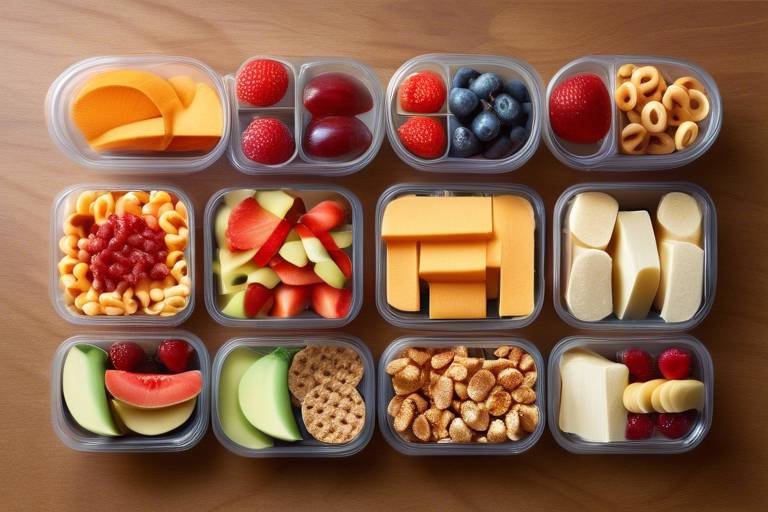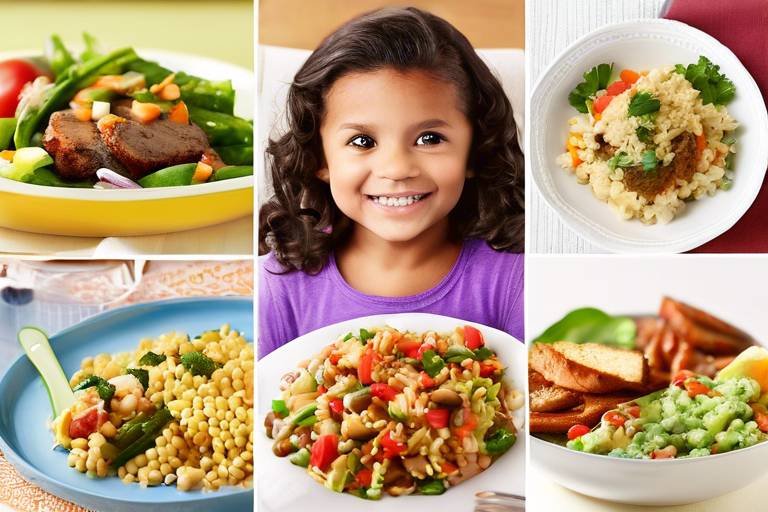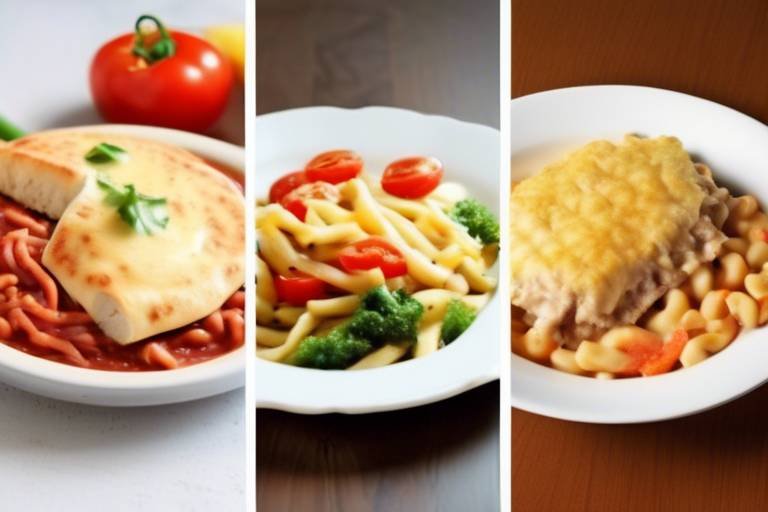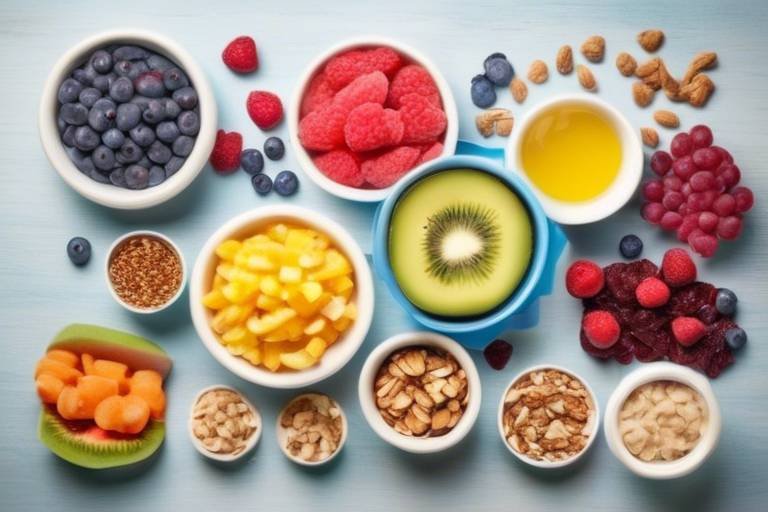Encouraging Healthy Eating Habits in Kids
In today’s fast-paced world, encouraging healthy eating habits in children can feel like a daunting task for many parents. However, it’s essential to remember that instilling these habits early on can lead to a lifetime of benefits. From better physical health to improved cognitive function, the food choices children make today can have profound implications on their future. So, how can we make healthy eating not just a chore, but an enjoyable part of their daily lives? In this article, we will explore effective strategies for fostering a positive relationship with food through engaging activities, parental influence, and a solid understanding of nutrition.
Understanding the role of nutrition in children's growth and development is crucial. During the early years of life, children experience rapid growth and development, making it vital for them to consume a balanced diet rich in essential nutrients. These nutrients are not just numbers on a label; they are the building blocks for physical health and cognitive development. For instance, protein is essential for growth, calcium strengthens bones, and vitamins and minerals support immune function. Parents need to emphasize the importance of these nutrients to help their children make informed choices about what they eat.
Parents play a significant role in shaping their children's eating behaviors. Kids are like little sponges, soaking up everything around them, including their parents’ attitudes toward food. If a parent views healthy eating as a burden, chances are their children will adopt a similar mindset. On the flip side, when parents embrace nutritious foods and share their enjoyment of them, children are more likely to develop positive eating habits. It’s all about creating a supportive environment where healthy eating is not just encouraged but celebrated!
One of the most effective ways to encourage healthy eating in kids is by modeling healthy choices. Children often emulate their parents’ eating habits, so when they see their parents reaching for fruits and vegetables instead of chips or sugary snacks, they are more likely to follow suit. This doesn’t mean you have to be perfect; it’s about showing balance and moderation. For example, if you enjoy a piece of chocolate cake, talk about it as a special treat rather than an everyday occurrence. This approach teaches kids that while indulgences are okay, they should be balanced with healthier options.
Establishing a supportive environment for healthy eating at home can greatly influence children's food preferences. Here are a few practical tips for creating a positive food atmosphere:
- Keep healthy snacks accessible, like fruits and nuts, while minimizing junk food in the pantry.
- Make mealtime a family affair, where everyone sits down together and enjoys the food.
- Encourage open discussions about food and nutrition, allowing children to express their thoughts and preferences.
By fostering a positive food environment, you create a space where children feel comfortable exploring new foods and making healthier choices.
Engaging children in cooking can foster a love for healthy foods. When kids help prepare meals, they are more likely to take an interest in what they are eating. This involvement can range from simple tasks like washing vegetables to more complex activities like measuring ingredients or assembling a salad. Not only does it teach them valuable life skills, but it also allows them to take ownership of their food choices. Plus, cooking together can be a fun bonding experience that creates lasting memories.
Teaching children about nutrition in an age-appropriate manner can empower them to make healthier choices. Start with the basics: explain why certain foods are good for their bodies and how they help them grow strong and smart. Use fun, interactive methods such as games or apps that focus on nutrition. For example, you could create a simple chart that highlights different food groups and their benefits, making it visually engaging for kids. By equipping them with knowledge, you’re giving them the tools to make informed decisions about their diets.
Making healthy eating enjoyable can significantly impact children's willingness to try new foods. This is where creativity comes into play! Think of ways to turn healthy eating into a fun adventure. For instance, you could organize a weekly “taste test” night where family members sample different fruits or vegetables and rate them. This not only makes trying new foods exciting but also fosters a sense of community around healthy eating.
Incorporating games and activities centered around food can make healthy eating more appealing. Consider organizing a scavenger hunt at the grocery store where kids have to find specific healthy items. Or, you could create a “Rainbow Plate” challenge, encouraging kids to include a variety of colorful fruits and vegetables in their meals. These interactive activities not only educate but also make the process of choosing healthy foods a fun experience.
The way food is presented can influence children's willingness to try it. Instead of serving plain broccoli, try arranging it into fun shapes or pairing it with a tasty dip. You could even create a “food art” night where kids can assemble their meals into creative designs, like animal shapes or smiley faces. The more visually appealing the food, the more likely kids will be excited to eat it!
Q: How can I encourage my child to try new foods?
A: Start by introducing new foods alongside their favorites. Make it fun by involving them in the cooking process or presenting the food in an engaging way.
Q: What if my child refuses to eat vegetables?
A: Be patient and persistent. Try different cooking methods, such as roasting or blending veggies into smoothies, and always model healthy eating yourself.
Q: How important is it to limit sugary snacks?
A: While it’s okay to have treats occasionally, limiting sugary snacks is crucial for maintaining a balanced diet and preventing unhealthy habits.

The Importance of Nutrition for Kids
Understanding the role of nutrition in children's growth and development is crucial. During the early years, children are like sponges, absorbing everything around them, including the food they eat. The right balance of nutrients can significantly impact their physical health, cognitive abilities, and emotional well-being. Think of nutrition as the fuel for a car; without the right fuel, the car won't run efficiently. Similarly, without proper nutrition, children's bodies and brains may not function optimally.
Essential nutrients play a vital role in various aspects of a child's development. For instance, proteins are the building blocks of growth, helping in the development of muscles, tissues, and even the brain. Carbohydrates provide the necessary energy for their daily activities, making them feel lively and engaged. Meanwhile, healthy fats are crucial for brain development, supporting cognitive functions and enhancing memory. Additionally, vitamins and minerals, such as calcium and iron, are fundamental for strong bones and overall health.
To illustrate the importance of these nutrients, consider the following table:
| Nutrient | Function | Sources |
|---|---|---|
| Proteins | Builds and repairs tissues | Meat, fish, eggs, beans, nuts |
| Carbohydrates | Provides energy | Whole grains, fruits, vegetables |
| Healthy Fats | Supports brain development | Avocados, nuts, olive oil |
| Vitamins & Minerals | Supports various bodily functions | Fruits, vegetables, dairy products |
It's important to note that poor nutrition can lead to several health issues, including obesity, diabetes, and even mental health problems. Children who consume a diet high in processed foods and sugars may struggle with attention and focus, impacting their learning abilities. Thus, instilling healthy eating habits early on is not just a matter of preference; it is a necessity for their overall well-being.
Moreover, teaching kids about nutrition and its effects can empower them to make better food choices. When children understand why they need certain foods, they are more likely to embrace healthy eating habits. This knowledge can be a game-changer, transforming mealtime from a mundane task into an exciting adventure of discovery and health.
In conclusion, the importance of nutrition for kids cannot be overstated. By providing them with the right nutrients, we are not only nurturing their bodies but also their minds and spirits. As parents and caregivers, we hold the key to shaping their future health, making it vital to prioritize nutrition in their everyday lives.

Parental Influence on Eating Habits
When it comes to shaping a child's eating habits, parents hold a powerful influence. Think of it like planting a garden; the seeds of healthy eating are sown through parental choices, attitudes, and behaviors. From the moment a child is born, they begin to observe and mimic their parents' actions, especially in relation to food. This means that if you, as a parent, prioritize nutritious foods and exhibit a positive attitude towards healthy eating, your child is likely to follow suit. On the flip side, if unhealthy snacks and negative attitudes towards food dominate your household, your child may adopt those habits too.
Research has shown that children are more inclined to eat fruits and vegetables if they see their parents enjoying these foods. It’s not just about the food on the table but also the conversations around it. For instance, discussing the benefits of certain foods while preparing dinner can instill a sense of curiosity and appreciation in kids. This leads to a deeper understanding of why healthy eating is essential, which can foster lifelong habits. Parents can also create a supportive environment by making healthy options readily available and minimizing the presence of junk food. This approach not only encourages children to make better choices but also helps them develop a positive relationship with food.
Moreover, the emotional connection to food is often rooted in family dynamics. Meals shared together can create a sense of community and belonging, reinforcing the idea that food is not just fuel but also a source of love and connection. By making mealtime a family affair, parents can encourage children to try new foods in a safe and supportive atmosphere. This shared experience can lead to more adventurous eating habits as children feel more comfortable exploring different flavors and textures.
It's also crucial for parents to be aware of their own eating behaviors. If a parent frequently skips meals, opts for fast food, or shows disdain for certain healthy options, children may internalize these behaviors as acceptable. Instead, parents should strive to be role models. This includes not only choosing nutritious foods but also demonstrating moderation and balance. For example, enjoying a slice of cake at a birthday party while also emphasizing the importance of fruits and vegetables can teach children that it’s okay to indulge occasionally, as long as it’s balanced with healthy choices.
In summary, the impact of parental influence on eating habits cannot be overstated. By modeling healthy eating behaviors, creating a positive food environment, and fostering open discussions about nutrition, parents can lay the groundwork for their children to develop a healthy relationship with food. Remember, you are not just feeding your child; you are teaching them lifelong skills that will shape their health and well-being for years to come.

Modeling Healthy Choices
When it comes to instilling healthy eating habits in children, the saying "actions speak louder than words" couldn't be more true. Children are like little sponges, soaking up everything around them, especially from their parents. If you want your kids to embrace healthy eating, it’s essential to model healthy choices yourself. This doesn’t just mean occasionally opting for a salad over fries; it’s about creating a lifestyle that prioritizes nutrition. Think of it as setting the stage for a lifelong performance of healthy habits!
Imagine sitting around the dinner table, where the vibrant colors of fresh vegetables and fruits create a feast for the eyes. Instead of serving up processed snacks, you might find a bowl of colorful bell peppers or a platter of sliced apples. When kids see their parents enjoying these foods, they are more likely to want to try them. It’s like planting seeds of curiosity and flavor in their minds. The more they see you enjoying nutritious meals, the more likely they are to follow suit.
Moreover, discussing your food choices openly can be incredibly impactful. Share with your children why you choose to eat certain foods. For instance, you might say, "I love this spinach salad because it gives me energy and helps my brain work better!" This not only educates them about nutrition but also makes them feel included in the conversation. You can even turn it into a fun game—ask them to guess which foods are good for different body functions, like strong bones or healthy skin.
Incorporating healthy habits isn’t just about the food itself; it’s also about the overall attitude towards eating. If you approach meals with a sense of joy and gratitude, your children will likely adopt that same perspective. Try to avoid negative language around food, such as "I shouldn’t eat this" or "I’m on a diet." Instead, focus on the positives. Celebrate the deliciousness of a homemade vegetable stir-fry or the satisfaction of a wholesome breakfast. This helps children develop a positive relationship with food that lasts a lifetime.
To further reinforce these healthy choices, consider creating a family food challenge. Each week, pick a new fruit or vegetable to try together. Make it fun! You can even rate how much everyone likes it and discuss different ways to prepare it. This not only encourages kids to be adventurous eaters but also strengthens family bonds through shared experiences. Remember, the goal is to make healthy eating a family affair rather than a chore.
In summary, modeling healthy choices is a powerful tool in shaping your children's eating habits. By embracing nutritious foods yourself, discussing your choices, and creating a positive food environment, you're setting the foundation for a lifetime of healthy eating. So, the next time you reach for a snack, remember: your little ones are watching and learning from you. Make every bite count!

Creating a Positive Food Environment
Creating a positive food environment at home is essential for fostering healthy eating habits in children. This environment is not just about the food that's available; it's about the overall atmosphere and attitudes surrounding meals and snacks. Think of your kitchen and dining area as a canvas where healthy eating can be painted in vibrant colors. The way you set up this space can significantly influence your child's relationship with food.
First off, consider the availability of healthy options. Stock your pantry and fridge with a variety of nutritious foods. When kids open the fridge and see colorful fruits and veggies, whole grains, and lean proteins, they are more likely to reach for these options instead of sugary snacks. It’s like setting the stage for a performance; when the right ingredients are in the spotlight, healthy eating becomes the star of the show.
Another crucial aspect is the family meal routine. Eating together as a family is not just about sharing food; it's about sharing experiences. Make it a habit to sit down for meals as often as possible. This practice allows children to observe and learn from their parents' eating habits. Plus, it provides a wonderful opportunity to discuss the food on the table, its benefits, and even the stories behind it. You could even turn this into a fun ritual where each family member shares something they learned about a specific food or recipe.
Moreover, creating a welcoming atmosphere during meals can make a world of difference. Try to eliminate distractions like television or smartphones. Instead, focus on engaging conversations that make the dining experience enjoyable. You might even want to decorate the dining area with colorful tableware or fun placemats that make meals feel special. This approach transforms eating from a mundane task into a delightful event, encouraging kids to appreciate the food they consume.
Involving children in the food selection process can also enhance their connection to healthy eating. When kids help choose fruits and vegetables at the grocery store or farmers' market, they feel a sense of ownership over their food choices. This involvement can lead to increased willingness to try new foods. You could even create a “food passport” where they can track the different fruits and vegetables they’ve tried, making it an adventure of sorts!
Finally, don't forget the power of positive reinforcement. Celebrate small victories when your child tries a new healthy food or finishes their vegetables. Compliments and encouragement go a long way in building their confidence and willingness to explore more nutritious options. Remember, the journey to healthy eating is a marathon, not a sprint, and every small step counts.
In summary, creating a positive food environment is about more than just the food itself; it’s about cultivating a space that encourages curiosity, enjoyment, and a lifelong appreciation for healthy eating. By being intentional about your home environment, you can help your children develop a strong foundation for making healthy choices that last a lifetime.
- What are some healthy snacks I can keep at home? Fruits, yogurt, nuts, and whole-grain crackers are great options!
- How often should we have family meals? Aim for at least 3-4 times a week to foster connection and healthy eating.
- How can I get my picky eater to try new foods? Involve them in meal prep and make trying new foods a fun challenge!

Involving Kids in Meal Preparation
Getting kids involved in meal preparation is not just a fun way to spend time together; it’s a fantastic strategy to instill healthy eating habits that can last a lifetime. When children participate in cooking, they not only learn essential skills but also develop a sense of ownership over their food choices. It’s like giving them a key to the pantry of healthy eating! Imagine your little one proudly declaring their involvement in making dinner—what a confidence booster!
One of the most significant benefits of involving kids in meal prep is that it can enhance their interest in trying new foods. When children help choose ingredients and see how meals come together, they become more curious about the flavors and textures involved. This hands-on experience encourages them to taste what they’ve created. Think about it: if your child helped chop vegetables or mix a salad, they’re more likely to give those foods a try. It’s a win-win situation!
Moreover, cooking together can be a delightful bonding experience. Picture this: you and your child donning aprons, laughing as you mix ingredients, and sharing stories about your day while waiting for the oven timer to beep. This interaction not only makes cooking enjoyable but also teaches valuable life skills, such as teamwork and patience. Plus, it’s a great opportunity to sneak in some lessons about nutrition. You can discuss why certain foods are healthier than others, turning an ordinary cooking session into a mini nutrition class!
Here are some creative ways to involve your kids in meal preparation:
- Grocery Shopping Together: Take your kids grocery shopping and let them pick out fruits and vegetables. This gives them a sense of responsibility and excitement about the food they’ll be preparing.
- Simple Tasks: Assign age-appropriate tasks. Younger children can wash veggies, while older kids can help with chopping or measuring ingredients. This way, everyone contributes!
- Recipe Selection: Let your kids choose a recipe they want to try. This will encourage them to be adventurous with their food choices.
Incorporating these practices into your routine can transform mealtime into an engaging and educational experience. Not only will you be teaching your children about healthy eating, but you’ll also be creating lasting memories. So, why not roll up your sleeves and get cooking together? You might just find that the kitchen becomes your family’s favorite place to be!
Q: What age should I start involving my child in meal preparation?
A: You can start involving your child in meal preparation as early as age 2 or 3. Simple tasks like washing fruits and vegetables can be a great start. As they grow older, you can introduce more complex tasks.
Q: How can I make cooking more fun for my kids?
A: Turn cooking into a game! Use fun utensils, play music, or even have a theme night where you cook dishes from different cultures. The more enjoyable the experience, the more likely they will want to participate.
Q: What if my child is picky about food?
A: Involve them in the cooking process! Allow them to choose ingredients and help prepare meals. This can encourage them to try new foods and develop a more adventurous palate.

Education on Nutrition
Teaching children about nutrition is not just a chore; it’s an adventure filled with discovery! Imagine your little ones equipped with the knowledge to make healthy choices, like superheroes of their own health. By introducing them to the world of nutrition in an age-appropriate and engaging way, we can empower them to take charge of what goes on their plates. This journey starts with understanding the basics—what nutrients are, why they matter, and how they affect our bodies.
First things first, let’s break it down into bite-sized pieces. Kids are naturally curious, so why not use that curiosity to our advantage? Start with simple concepts. Explain the different food groups using fun visuals or even a colorful food pyramid to illustrate how various foods contribute to their growth and energy levels. A little creativity goes a long way! For example, you could use a
| Food Group | Examples | Benefits |
|---|---|---|
| Fruits | Apples, Bananas, Berries | Rich in vitamins and fiber |
| Vegetables | Carrots, Broccoli, Spinach | Loaded with nutrients and antioxidants |
| Grains | Rice, Oats, Whole Wheat Bread | Provide energy and essential nutrients |
| Proteins | Chicken, Eggs, Beans | Important for growth and repair |
| Dairy | Milk, Yogurt, Cheese | Good source of calcium for strong bones |
Next, make it interactive! Kids love hands-on activities. Consider organizing a fun cooking session where they can prepare simple, healthy recipes. As they chop vegetables or mix ingredients, explain the nutritional benefits of each component. This not only teaches them about food but also instills a sense of accomplishment and pride in creating their meals.
Another engaging way to educate children about nutrition is through storytelling. Create fun characters that represent different nutrients or food groups. For instance, you could introduce “Captain Vitamin C” who helps boost immunity or “Fiber Fairy” who keeps our digestive system happy. This method transforms learning into an enjoyable experience, making the information stick in their minds.
Lastly, don’t forget to encourage questions! When children ask about what they eat, it’s a golden opportunity to explain and share knowledge. Instead of simply answering, involve them in the conversation. Ask them what they think about certain foods or how they feel after eating different meals. This dialogue not only fosters critical thinking but also reinforces the importance of making informed choices.
In conclusion, education on nutrition is a vital part of nurturing healthy habits in children. By making learning fun, interactive, and relatable, we can inspire the next generation to embrace a healthy lifestyle. Remember, every little step counts, and with the right guidance, our kids can become champions of their own health!
- What age should I start teaching my child about nutrition?
It's never too early! Start introducing basic concepts around age 3, and build on that knowledge as they grow. - How can I make healthy foods more appealing to my kids?
Try creative presentations, such as arranging fruits and veggies into fun shapes or using colorful plates. - What if my child refuses to try new foods?
Encourage them to taste without pressure. Sometimes it takes several exposures to a new food before a child is willing to try it.

Fun Ways to Encourage Healthy Eating
Getting kids excited about healthy eating can sometimes feel like a Herculean task, but it doesn't have to be! The key lies in making nutritious foods not just healthy, but also fun and engaging. When children associate healthy eating with enjoyable experiences, they’re more likely to embrace it. So, how can we sprinkle some magic into mealtime? Let’s dive into a treasure trove of creative ideas that can transform your kitchen into a vibrant hub of healthy eating!
One of the most effective methods to encourage healthy eating is through interactive food activities. Imagine turning a regular dinner into a mini cooking class! You can set up a "build-your-own" taco night where kids can choose from a variety of healthy toppings like grilled chicken, fresh veggies, and guacamole. This not only empowers them to make their own choices but also makes them more likely to try new foods. You can even introduce a friendly competition—who can create the most colorful taco? This playful approach can make healthy foods appealing and exciting.
Another fantastic way to make healthy eating fun is through the creative presentation of food. Kids are naturally drawn to visually appealing meals. You can create fun shapes using cookie cutters or arrange fruits and vegetables into fun designs on their plates. For example, a simple fruit salad can become a rainbow of colors, and you can even challenge your kids to eat the colors of the rainbow throughout the week. This not only makes the meal more inviting but also encourages them to eat a variety of nutrients.
Moreover, incorporating games and challenges can be a game-changer. You could create a "healthy eating bingo" card where each square represents a different fruit or vegetable. As they try each item, they can mark it off on their card. The first one to get a bingo can win a small prize! This not only motivates them to try new foods but also turns healthy eating into an exciting game.
Lastly, don’t underestimate the power of storytelling! You can create fun narratives around certain foods. For instance, tell a story about how carrots help bunnies see better or how spinach makes you strong like Popeye. These stories can ignite their imagination and make them more curious about trying these foods. When children see food as part of an adventure, they are far more likely to want to taste it.
In conclusion, encouraging healthy eating in kids doesn’t have to be a battle. By incorporating fun activities, creative presentations, and engaging narratives, we can foster a love for nutritious foods. Remember, the goal is to make healthy eating a delightful experience that kids will carry with them into adulthood. After all, when healthy eating becomes synonymous with fun, it’s a win-win for everyone!
- How can I get my child to try new foods? Start with small portions and pair new foods with familiar favorites. Encourage them to explore different textures and flavors without pressure.
- What are some healthy snacks for kids? Fresh fruits, yogurt, whole-grain crackers, and veggie sticks with hummus are excellent choices that are both nutritious and appealing.
- How important is it for parents to model healthy eating? Extremely! Children often imitate their parents’ behaviors, so showing a positive attitude towards healthy foods can greatly influence their choices.

Interactive Food Activities
When it comes to encouraging kids to eat healthy, making the experience interactive can be a game changer. Imagine transforming mealtime into a fun adventure where your children are not just passive eaters but active participants in the culinary journey. This approach not only piques their curiosity but also lays the foundation for a lifelong appreciation of nutritious foods. So, how can we spice things up and make healthy eating a delightful experience for our little ones?
One of the most effective ways to engage children is through cooking games. You can set up a mini cooking competition in your kitchen, where kids can create their own healthy snacks using fruits, vegetables, and whole grains. For instance, challenge them to assemble the most colorful fruit salad or to create a sandwich using only healthy ingredients. This not only boosts their creativity but also teaches them about food combinations and nutrition in a playful setting.
Another fantastic idea is to organize a food scavenger hunt. Create a list of healthy items, such as different fruits, vegetables, or whole grain products, and have your kids search for them in the grocery store. This activity not only makes shopping exciting but also educates them about various food groups. You could even turn it into a family event, where everyone participates, making it a bonding experience.
Additionally, you can incorporate gardening into your interactive food activities. If you have space, start a small vegetable or herb garden at home. Kids love to dig in the dirt, and watching their plants grow can spark an interest in where their food comes from. Once the veggies are ready, involve them in the cooking process, emphasizing the journey from garden to table. This connection can significantly enhance their willingness to try new foods.
Finally, don't underestimate the power of creative presentations. You can turn ordinary meals into extraordinary experiences by arranging food into fun shapes or using vibrant colors. For example, use cookie cutters to create star-shaped sandwiches or arrange fruits into a rainbow on their plates. Such visual appeal can entice even the pickiest eaters to take a bite!
In summary, making healthy eating interactive is all about creativity and engagement. By incorporating cooking games, scavenger hunts, gardening, and creative presentations into your routine, you can turn meal times into joyful experiences that foster a love for nutritious foods. Remember, the goal is to create positive associations with healthy eating, ensuring that these habits stick with them for life.
- What are some easy healthy snacks I can prepare with my kids?
Some easy options include fruit skewers, yogurt parfaits with granola and berries, or whole grain wraps filled with veggies and hummus.
- How can I encourage my child to try new foods?
Involve them in the cooking process, present the food creatively, and keep a positive attitude about trying new things.
- Are there any fun food-related games I can play with my kids?
Yes! You can play 'Guess the Fruit' where they blindfolded guess different fruits by taste or texture, or create a food-themed bingo game.

Creative Presentation of Food
When it comes to encouraging kids to eat healthy, the presentation of food can make a world of difference. Think about it: if you were served a plain plate of broccoli versus a vibrant, colorful broccoli tree with a side of “dinosaur eggs” (a.k.a. cherry tomatoes), which one would you be more excited to eat? Kids are naturally drawn to fun and visually appealing meals, so why not take advantage of that? Making food look exciting can spark their curiosity and encourage them to try new things.
One effective way to enhance food presentation is by using creative shapes and colors. For instance, using cookie cutters to shape fruits and vegetables into stars, hearts, or animals can turn an ordinary snack into a playful experience. Additionally, arranging food into rainbow patterns not only looks beautiful but also ensures a variety of nutrients. A plate filled with red strawberries, orange carrots, yellow corn, green peas, and blue blueberries not only pleases the eye but also provides a nutritional powerhouse.
Another engaging method is to create themed meals. Imagine a “Under the Sea” theme with blue gelatin for the ocean, fish-shaped sandwiches, and seaweed salad (which can be made from spinach). Kids love stories, and when their meals tell a story, they are more likely to dig in. You can even involve them in the process by asking them to help create these fun themes, making mealtime a collaborative and enjoyable experience.
To further enhance the excitement around healthy eating, consider the idea of DIY food stations. Set up a taco bar where kids can choose their toppings or a smoothie station where they can mix and match fruits. This not only gives them control over their meals but also makes the process of eating healthy interactive and fun. Plus, they’ll be more inclined to eat what they’ve created themselves!
Lastly, don’t underestimate the power of fun utensils and plates. Using brightly colored plates, fun-shaped bowls, or even animal-themed cutlery can make a simple meal feel like a special occasion. You can also introduce edible decorations like sprinkles made from nuts or shredded coconut to add a touch of whimsy to fruit salads or yogurt.
In summary, the key to encouraging kids to embrace healthy eating lies in the art of presentation. By making meals colorful, themed, interactive, and fun, you can transform the way children view nutritious foods. Remember, the more exciting and engaging the food looks, the more likely they are to give it a try. So roll up your sleeves, get creative, and watch as your little ones develop a love for healthy eating!
- How can I encourage my child to try new foods? Start by making the food fun and visually appealing. Involve them in the cooking process and offer a variety of options.
- What are some easy ways to present food creatively? Use cookie cutters, vibrant colors, and themed meals to make food more appealing.
- Why is presentation important for kids? Kids are more likely to eat healthy foods that are visually exciting and fun, which can help them develop better eating habits.
Frequently Asked Questions
-
What are some essential nutrients for children's growth?
Children need a variety of nutrients to support their growth and development. Key nutrients include proteins for muscle development, calcium for strong bones, iron for healthy blood, and vitamins A, C, and D for overall health and immunity. A balanced diet rich in fruits, vegetables, whole grains, and lean proteins can help ensure they receive these essential nutrients.
-
How can I model healthy eating for my kids?
Kids are like little sponges—they absorb everything! By making healthy food choices yourself, you set a powerful example. Share meals together, choose nutritious snacks, and talk about why you love certain foods. This not only encourages them to try new things but also helps them develop a positive relationship with food.
-
What are some fun ways to get kids involved in meal preparation?
Getting kids involved in cooking can be a blast! Let them help wash vegetables, mix ingredients, or even create their own sandwiches. You could also make it a game by having them choose a healthy recipe or create a colorful salad. This hands-on approach can spark their interest in healthy eating and make mealtime more enjoyable.
-
How can I create a positive food environment at home?
Creating a positive food environment starts with having healthy options readily available. Stock your kitchen with fruits, veggies, and whole grains. Make mealtime a family affair—sit together, share stories, and enjoy the food. Avoid using food as a reward or punishment, as this can create negative associations with eating.
-
What educational strategies can I use to teach my kids about nutrition?
Use fun and interactive methods to teach kids about nutrition. You can create a colorful food pyramid together, play nutrition-related games, or even visit a local farmer's market. The key is to keep it age-appropriate and engaging, so they feel empowered to make healthier choices.
-
How can I make healthy foods more appealing to my kids?
Presentation is everything! Try arranging fruits and veggies in fun shapes or using colorful plates. You can also involve your kids in the process of making their meals look appealing, which can make them more excited to eat healthy. Remember, a little creativity goes a long way!
-
Are there any interactive food activities I can try with my children?
Absolutely! You could organize a “food art” day where kids create pictures using fruits and veggies, or host a cooking competition with healthy ingredients. Even simple activities like taste testing different fruits or having a “build your own taco” night can make healthy eating fun and engaging.



















